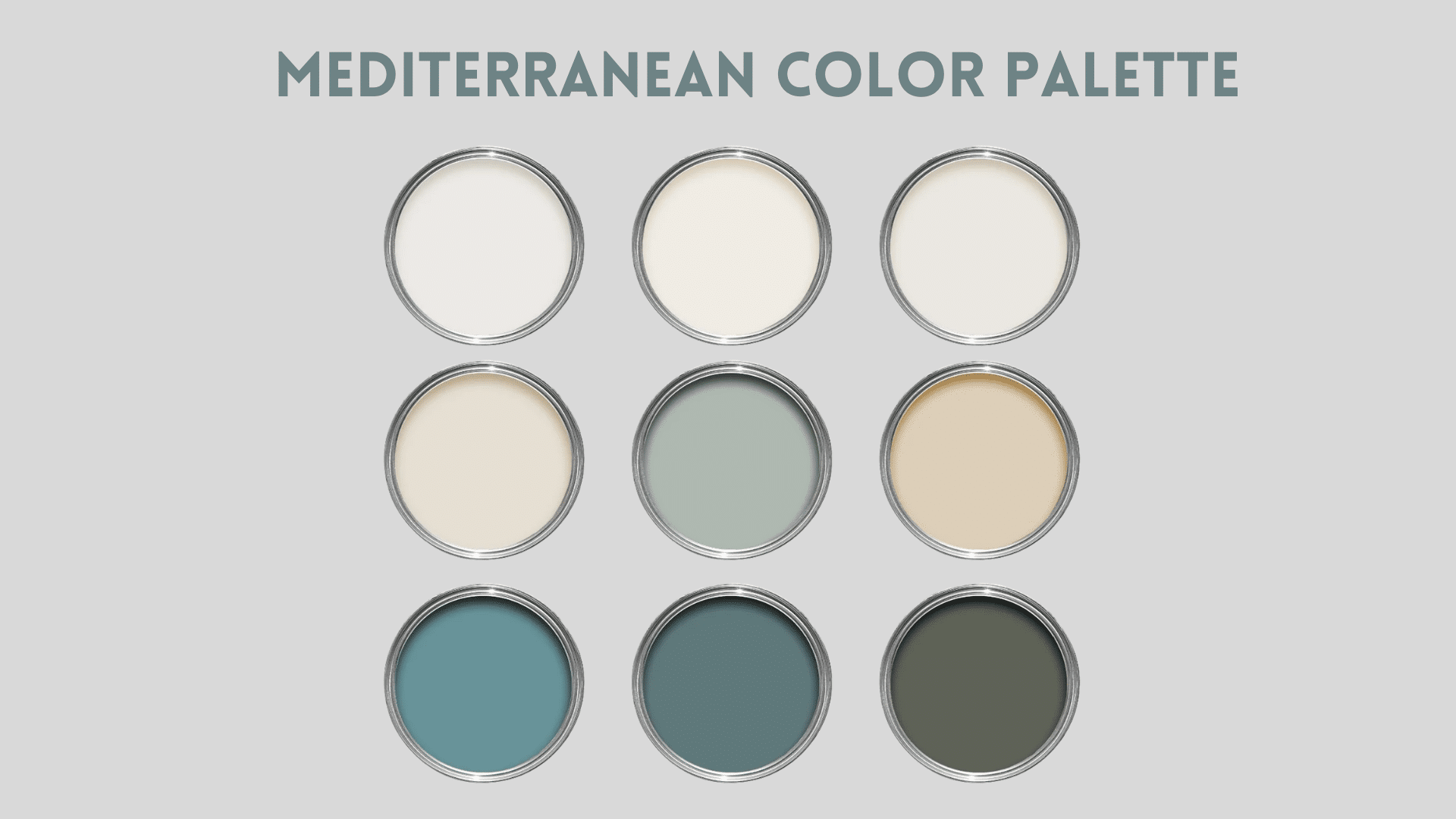Finding the perfect color scheme that balances warmth with serenity can be a real challenge. The Mediterranean color palette offers exactly this—a blend of sun-soaked hues and cool coastal tones that work together beautifully.
However, figuring out how to simplify it for a minimalist space often feels overwhelming.
I’m here to help you capture that Mediterranean magic without the clutter. In this guide, I’ll show you how to select and combine key Mediterranean colors that maintain minimalist principles while still evoking that coastal charm we all love.
You’ll find the essential colors to focus on, simple combining techniques, and room-by-room suggestions that keep your space clean and uncluttered while radiating that timeless Mediterranean warmth.
What is the Mediterranean Color Palette?
The Mediterranean color palette draws from the coastal villages of Greece, Italy, Spain, and North Africa. It blends bright whites with ocean blues, sandy neutrals, and earthy clay tones.
These colors reflect the region’s natural beauty—think clear skies, calm seas, and sunlit buildings.
Unlike bold designs that use all colors at once, a minimalist take on Mediterranean style focuses on careful selection. It’s about choosing a few key shades that capture the feeling without filling your space with too many items or colors.
Colors That Define Mediterranean Style
At its heart, the Mediterranean palette includes whites, blues, and earth tones.
- White acts as the base, reflecting light and making spaces feel open.
- Blues range from light sky tones to deep sea shades, bringing calm to any room.
- Earth tones like clay, sand, and stone add warmth and balance. The beauty of these colors comes from their natural origins.
Each shade connects to something real—the white of sun-bleached walls, the blue of clear water, or the red-brown of clay pots.
Characteristics of the Mediterranean Color Palette
1. Bright and Vibrant
The Mediterranean color palette bursts with energy, capturing the region’s endless sunshine. Think vivid blues reminiscent of the sparkling sea, radiant yellows echoing sun-drenched fields, and pops of coral or turquoise mirroring blooming flora.
These colors aren’t shy—they dance together in cheerful harmony, reflecting a lively, optimistic spirit. Whether splashed across a villa’s walls or woven into textiles, the brightness lifts moods and celebrates life under the Mediterranean sun, making spaces feel alive, dynamic, and endlessly joyful.
2. Natural and Earthy
Rooted in the rugged landscapes of the Mediterranean, this palette embraces nature’s raw beauty. Deep terracotta mimics sun-baked clay, olive greens nod to sprawling groves, and sandy beiges reflect coastal dunes.
These earthy hues feel organic, grounding spaces with a sense of authenticity. Paired with stone grays or warm browns, they evoke the region’s hillsides and rustic charm, creating an unpretentious elegance that connects interiors to the timeless outdoors.
3. Warm and Inviting
The Mediterranean palette radiates warmth, wrapping spaces in a cozy, welcoming embrace. Golden yellows and soft oranges glow like late afternoon light while rich reds and creamy whites suggest hearth and home.
These tones soothe the soul, inviting relaxation and togetherness—perfect for long meals or quiet evenings. The warmth isn’t overpowering; it’s a gentle comfort, reminiscent of a seaside retreat, making every corner feel like a haven of peace and hospitality.
4. Timeless and Classic
With roots in ancient villas and coastal villages, the Mediterranean palette transcends trends. Its blues recall timeless seas, whites echo marble ruins, and warm ochres hint at centuries-old architecture.
This enduring quality adapts effortlessly—whether in a rustic farmhouse or a sleek modern space. The colors carry a storied elegance, blending tradition with versatility, ensuring they remain relevant and sophisticated across generations, a nod to a heritage that never fades.
5. Balanced
Harmony defines the Mediterranean palette, blending cool and warm tones with finesse. Crisp whites and tranquil blues—think sea and sky—meet sunny yellows and earthy reds in perfect equilibrium.
This balance avoids extremes, creating a cohesive flow that’s both refreshing and grounding. The interplay feels natural, like a coastal breeze tempering summer heat, ensuring spaces feel serene yet vibrant. It is a thoughtful mix that delights the eye and calms the spirit.
Room-Specific Mediterranean Color Suggestions
Each room in your home offers unique ways to incorporate Mediterranean colors while maintaining a minimalist approach. By focusing on the right colors for each space, you can create flow throughout your home without making it feel busy or complicated.
1. Living Room
Start with off-white walls for a fresh, airy living room. Add soft blue through cushions or an armchair for a coastal feel. Touches of terracotta, like in a vase or artwork, balance the cool tones.
Natural materials such as wood or stone enhance warmth without complicating the design.
2. Kitchen
In the kitchen, light wood cabinetry adds warmth. A small blue or green tile backsplash brings Mediterranean charm without clutter. Keep shelves minimal with a few decorative pieces, like a clay pitcher or blue glassware, for color.
3. Bedroom
For a peaceful bedroom, choose soft green walls or bedding for calm. White linens keep the space fresh, while light wood furniture adds warmth. Avoid too much blue, as green and neutral tones are more restful. A plant brings in color and life.
Regional Variations and Key Themes for Mediterranean Color
The Mediterranean area shows notable color differences across its regions. Each place has its own color story to tell.
Colors change from one coastal town to another. Spain often uses warm yellows and oranges in its buildings. These tones reflect the sunny climate and local soil.
Greece tends toward crisp whites and blues. The white walls bounce back the harsh sun. Blue domes and doors echo the sea and sky beyond.
Italy brings in more earth tones. Tuscan homes might use soft browns, rust reds, and muted yellows. These colors come from local clay and minerals.
Morocco adds its own flavor with bold blues and rich reds. Tiles and textiles show complex patterns in these strong tones.
What ties these areas together? The light. Mediterranean sunlight has a clear quality that makes colors look bright. The sea’s influence also plays a role. Blue-green water tones appear in local designs.
Natural materials drive color choices, too. Stone, clay, and local pigments shaped traditional building practices. People used what they could find nearby.
Key Mediterranean Colors to Use in Minimalist Design
The true charm of a Mediterranean color scheme lies in a few carefully selected shades. For minimalist spaces, focusing on the most essential colors creates impact without clutter. These key colors bring the Mediterranean feeling while maintaining clean, simple spaces.
| Key Mediterranean Color | Details |
|---|---|
| Terracotta & Clay | Warm red-brown tones; use as small accents like pottery, pillows, or area rugs. |
| Soft Blues & Sea Greens | Muted ocean colors bring calm; use in accent pieces or paint a bathroom in soft sea blue. |
| Neutral Hues | White, off-whites, and beige create a bright, spacious feel; use these on walls, furniture, and floors. |
Conclusion
Now that you’ve examined the essential elements of a minimalist Mediterranean color palette, it’s time to make these ideas your own. Remember that less truly is more – focus on quality over quantity.
What matters most is how these colors make you feel in your space. Start with one room, perhaps your living area or bedroom, and gradually build your palette from there.
Take cues from the natural world around you. Even if you live far from the Mediterranean, thoughtful color choices can help you capture its essence.
The beauty of this approach is its simplicity. By combining whites, blues, and earth tones with intention, you’ll create a home that feels both timeless and fresh – a peaceful retreat that welcomes you back day after day.
Frequently Asked Questions
1. What are the Main Colors in the Mediterranean Palette?
The Mediterranean color palette features a mix of earthy tones like terracotta, golden yellows, and soft neutrals paired with cool blues, turquoise, and greens.
2. How Can I Use Mediterranean Colors in a Minimalist Design?
In a minimalist design, focus on using neutral bases such as whites and beige for walls and large furniture. Accent with Mediterranean blues, greens, or terracotta in small doses through cushions, artwork, or textiles.
3. Can I Combine Different Mediterranean Color Tones in One Room?
Yes, you can! The key is balance. Use a dominant neutral color like white or beige, then introduce Mediterranean accent colors like turquoise, terracotta, or deep blues for visual interest.












